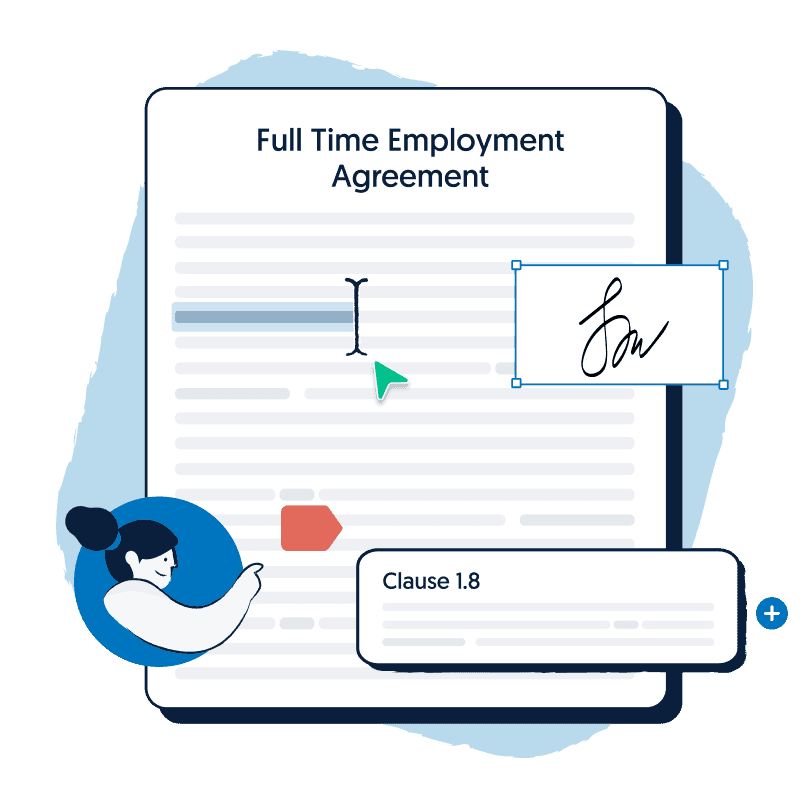💡Key Insight:
- Full-time employees generally work around 38 ordinary hours per week and receive the full range of National Employment Standards entitlements.
- Part-time employees work fewer than 38 hours per week on a regular, ongoing schedule and receive the same entitlements on a pro-rata basis.
- The main differences relate to hours, flexibility, and how leave, overtime, and pay are calculated, not the type of legal protections provided.
- Employers must correctly classify employees and document agreed hours to ensure compliance with Fair Work obligations and avoid underpayment risks.
Do you run a small business and are considering hiring employees? Or are you an employee just trying to figure out what you deserve under Australian law?
In both situations, entitlements for part-time and full-time employees vary significantly, and it’s important to know which ones apply.
This article will discuss the difference between part-time and full-time employees. Whether you’re trying to determine on what basis you’ll hire someone or what rights you have as an employee, this guide will provide the answers.
Table of Contents
What is a full-time employee?
The Fair Work Act defines different employment types in Australia. A full-time employee works an average of 38 ordinary hours per week, or the hours defined in an applicable modern award or enterprise agreement. They are employed on an ongoing basis and receive the full range of National Employment Standards (NES) entitlements.
Here are the key aspects that qualify a person as a full-time employee:
- Hours worked: Full-time employees usually work 38 hours a week. However, this may differ depending on the industry or award. For example, under certain hospitality or healthcare awards, full-time hours may average slightly differently across rosters or shift cycles.
- Fixed and predictable schedules: Full-time workers typically have set hours and shifts each week, providing stability for both the employer and the employee. This predictability helps in long-term workforce planning and career progression.
- Full NES entitlements: Full-time employees receive all ten NES entitlements, including annual leave, personal leave, public holidays, notice of termination, redundancy pay, and requests for flexible work. They also have access to superannuation contributions at the standard employer rate (currently 12% as of 2025).
A full-time employment contract typically includes:
“You are employed on a full-time basis, working 38 hours per week. Your standard hours are Monday to Friday, 9 AM to 5 PM, with a 1-hour lunch break each day.”

Get your Full Time Employment Agreement legal document for free.
What is a part-time employee?
In contrast, a part-time employee works fewer than 38 ordinary hours per week, typically with a consistent work schedule. They work on an ongoing basis, not on a temporary or casual arrangement.
Here are the key aspects of part-time employment:
- Regular ongoing pattern: Part-time employees have set days and hours that provide a regular income and job stability, albeit with a workload that is less than full-time. Their weekly hours are agreed upon and included in the employment contract.
- Pro-rata entitlements: Part-time employees receive the same NES entitlements as full-time employees but on a pro-rata basis.
- Flexibility in scheduling: While part-time arrangements offer flexibility, any changes in work hours should be mutually agreed upon in writing.
For example, if a full-time employee earns four weeks of annual leave per year, a part-time worker who works 3 days a week (3/5 of full-time hours) earns 12 days of annual leave per year. This calculator uses the following formula: Full-time = 20 days → Part-time = 3/5 × 20 = 12 days.

Get a free legal document when you sign up to Lawpath
Sign up for one of our legal plans or get started for free today.
Key differences between full-time and part-time employees: At-a-glance summary
| Category | Full-Time Employee | Part-Time Employee |
| Hours | Around 38 hours per week | Less than 38 hours per week, with a set pattern |
| Pay | Fixed salary or hourly wage | Hourly wage based on hours worked |
| Leave entitlements | Full NES benefits | Pro-rata of full-time entitlements |
| Flexibility | Less flexible, fixed hours | Often more flexible, subject to agreement |
| Job security | High, ongoing role | Ongoing but part-time arrangement |
| Superannuation | Standard 12% of ordinary earnings | Same rate, calculated on actual earnings |
| Overtime rules | Paid for hours beyond ordinary time | Paid overtime beyond agreed hours or full-time equivalent |
| Notice periods | Based on continuous service | Same, pro-rated if required |
| Award/Enterprise agreement | Sets standard hours, pay rates and entitlements | Same award coverage applies |
| Changing status | Can move to part-time with mutual agreement | Can increase hours or become full-time with agreement |
Minimum hours and NES entitlements explained
The NES set out the minimum standards that apply to employees. Under this, both types of employees can receive NES entitlements relating to:
- Maximum weekly hours
- Requests for flexible working arrangements
- Parental leave and related entitlements
- Annual leave
- Personal carers leave and compassionate leave
- Community service leave
- Long service leave
- Public holidays
- Notice of termination and redundancy pay
- The Fair Work Information Statement
The key difference between these types of employment is that full-time employees receive the full range of listed minimum entitlements. Part-time entitlements are the same but are calculated on a pro-rata basis.
Hours of work
Full-time hours in Australia usually refer to 38 ordinary hours per week. Part-time workers have agreed ordinary hours that are less than 38 hours but are consistent and predictable. Both can work additional hours if reasonable and agreed upon.
Breaks and overtime rules
Fair Work guidelines ensure that both employee types receive adequate rest and meal breaks. Overtime for full-time staff applies when hours exceed the ordinary working hours, typically attracting penalty rates. For part-time employees, overtime applies when they work beyond their contracted hours or over the standard 38-hour weekly threshold.

Need Financial or Legal Advice for your small business?
Annual, sick, and carers leave
Under the NES:
- Full-time employees earn a minimum of 4 weeks of annual leave and 10 days of paid personal/carer’s leave annually.
- Part-time employees receive leave entitlements proportionally.
Example:
If a full-time employee receives 20 days of annual leave per year, a part-time employee working 3 days per week gets: 3 ÷ 5 × 20 = 12 days.
This ensures equality across employment types on a proportional basis.
Public holidays
Both categories are entitled to a paid day off for any public holiday they would normally work. Part-time employees only receive pay for holidays that fall on their regular workdays.
Pros and cons for employers
How do you decide when to hire full-time vs part-time employees? Let’s take a look.
When full-time hiring makes sense
Hiring full-time employees is suitable for positions that require consistent output, long-term commitment, and strong company alignment.
It is ideal for roles such as management, administrative, or operational positions that benefit from workforce stability and familiarity with company systems.
When part-time hiring makes sense
Part-time employment works well for roles that need flexibility, such as customer service, retail, or administrative support. Employers can align staffing levels with business demand without overcommitting to full-time costs.
Cost differences explained
From a financial perspective:
- Full-time employees: Higher total payroll costs due to full entitlements and benefits.
- Part-time employees: Lower ongoing costs due to fewer hours and proportional entitlements, but higher per-hour operational costs in some cases.
When deciding your staffing needs, consider the entire overhead. Full-time roles may lead to additional fixed costs like equipment and benefits. That said, having full-time workers leads to accumulated knowledge, lower turnover, and more overall stability.
In the meantime, part-time positions allow greater workforce scalability and budget control. However, employers must carefully manage administrative tasks, such as tracking pro-rata entitlements.
Generally, the type of employees you hire depends on your business needs. Neither is better or worse — rather, it’s what works best for your business model.

Get a fixed-fee quote from Australia's largest lawyer marketplace.
Common mistakes employers make (and how to avoid them)
It’s crucial to manage your employees effectively with consistent contracts and fair terms. Here are some errors employers commonly make and how you can mitigate them.
- Misclassifying employees: Don’t confuse part-time employees with casual workers. Casual employees receive casual loading instead of leave entitlements, while part-timers receive pro-rata benefits.
- Not recording hours correctly: Keep accurate time records for part-time staff to ensure the correct calculation of leave, overtime, and superannuation.
- Failing to apply pro-rata properly: If you underpay or miscalculate leave based on incorrect hours, it can lead to Fair Work compliance breaches. Using automated HR software or payroll systems ensures accuracy.
- Not updating employment contracts: Your employment contracts should reflect actual work hours and schedules. Failing to update contracts after structural changes can expose you to disputes and penalties.
- Not complying with award conditions: Each modern award sets minimum conditions for both full-time and part-time employees. You should always check relevant awards to confirm correct pay levels and hourly entitlements.
It’s crucial to have all entitlements and expectations set out in a binding legal contract. Lawpath provides a wide range of professional legal templates, so you can easily adapt these to your business needs.

Get on demand legal advice for one low monthly fee.
Sign up to our Legal Advice Plan and access professional legal advice whenever you need it.
Changing an employee’s classification
If an employee is in full or part-time employment, it’s possible to change if both parties agree.
- Full-time to part-time: A full-time worker can request or be offered a change to part-time status. This requires a written agreement that specifies the new work hours, days, and entitlements. Any change must result from mutual agreement.
- Part-time to full-time: Similarly, a part-time worker can transition to full-time if business demand increases or employees wish to increase hours permanently. You’ll need to provide written confirmation and ensure compliance with Fair Work’s rules regarding variations to employment terms.
You must formalise all changes to hours or employment type in writing. The agreement should include:
- Proposed start date of change
- Updated ordinary hours
- Revised pay rate (if applicable)
- Acknowledgment of continued role and service
You also need to ensure that changing classification does not reduce statutory entitlements or breach award conditions. Under the NES, employees cannot be disadvantaged due to such changes.
FAQs
How many hours is full-time in Australia?
Full-time employees generally work 38 ordinary hours per week unless an award or enterprise agreement provides otherwise.
How many hours is part-time?
Part-time employees work fewer than 38 hours per week, with regular and predictable hours agreed upon in their employment contract.
Do part-time workers get paid more hourly?
Not usually. Part-time employees receive the same base rate as full-time staff under the same award, but can earn proportionally less due to fewer hours.
Do part-time employees get the same leave benefits?
Yes, they receive all NES leave entitlements on a pro-rata basis, including annual and personal leave.
Can part-time employees work full-time hours occasionally?
Yes, but any hours beyond their contracted ordinary hours may attract overtime rates, depending on the applicable award.
What’s better for small business owners?
Part-time hiring offers cost flexibility and adaptability during variable workloads. Full-time hiring is better for long-term, strategic roles where continuity is vital.
What documents do I need for each employment type?
Employers need a compliant employment contract, Fair Work Information Statement, and relevant award or enterprise agreement information for both employment types.
Need help setting up employment contracts?
Ensuring your employment agreements comply with Fair Work laws helps prevent disputes and penalties. Lawpath provides industry-compliant resources for Australian employers.
- Download our employment contract template
- Access our HR Policy Toolkit and HR contract packages
- Hire an employment lawyer for more in-depth support
These tools make it easier to clarify employee classifications, structure entitlements, and maintain compliance under the Fair Work Act.
Want more?
Sign up for our newsletter and be the first to find hand-picked articles on topics that we believe are crucial to successfully scale your unique small business.






